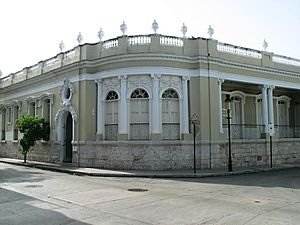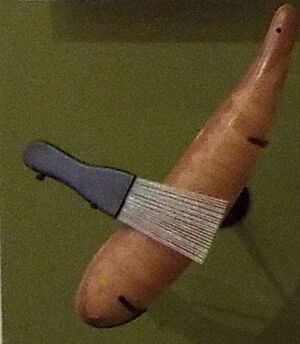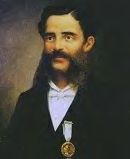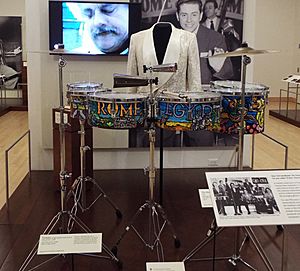Music of Puerto Rico facts for kids
The music of Puerto Rico is a vibrant mix of different cultures. Its main influences come from Spain and West Africa. But you can also hear sounds from other parts of Europe and the Caribbean. Today, Puerto Rican music includes many styles, from traditional sounds like bomba to newer ones like Latin trap and reggaeton. This music also includes the sounds made by millions of people of Puerto Rican heritage living in the United States, especially in New York City. Their music, like salsa and the boleros of Rafael Hernández Marín, is a big part of Puerto Rico's music story.
Contents
Traditional and Folk Music
For a long time, music in Puerto Rico wasn't well recorded. But we know it included Spanish church music, military band music, and dance music. This dance music was played by the jíbaros (country farmers) and enslaved Africans. Even though enslaved Africans were a smaller part of the population, they brought some of the most exciting musical styles to the island.
In the 1800s, Puerto Rican music started to be written down. Styles like the danza became better known than folk styles like jíbaro music, bomba, and plena.
Folk Music Styles
"Folk music" means music that grew popular without much official support or commercial media. In Puerto Rico, this includes jíbaro music (mostly Spanish-influenced), Afro-Puerto Rican bomba, and plena. These three styles developed uniquely in Puerto Rico. They are very important to the island's culture, even if they are not as popular today as salsa or reggaeton.
Jíbaro Music
Jíbaros were small farmers, mostly of Spanish background. They were the main part of Puerto Rico's population until the mid-1900s. People saw them as hard-working, friendly, and loving music and dance.
Their instruments were like Spanish guitars. The most famous is the cuatro, which changed from four single strings to five pairs of double strings. There was also the lesser-known tiple. Today, a jíbaro group might have a cuatro, a guitar, and percussion instruments. These include the güiro scraper or bongo drums.
Jíbaro songs often use a poetry style called décima. This has ten lines that rhyme. This style came from Spain in the 1500s. It became very popular in places like Cuba and Puerto Rico. Décimas can be pre-written or made up on the spot. Between the sung parts, the cuatro player often plays lively solos. This music is also called "típica."
There are about twenty common jíbaro song types. They are divided into two groups: seis (like seis fajardeño) and aguinaldo (like aguinaldo orocoveño). The seis used to be danced to, but this is rare now. Aguinaldo is mostly sung during the Christmas season. Groups of singers (called parrandas) go from house to house, singing and celebrating. Christmas is a time when you hear a lot of traditional jíbaro music. Many groups work hard to keep this music alive.
In the 1900s, jíbaro music was recorded. Singers like Ramito became famous. However, as farming changed and cities grew, there were fewer jíbaros. Many songs talked about moving to New York. Jíbaro music has become less common, but it is still important, especially at Christmas and special events. Many cuatro players are very skilled.
Bomba
Bomba is a music and dance style that started with enslaved people around the 1800s. By the mid-1900s, it was performed in different parts of the island, like Loíza, Ponce, San Juan, and Mayagüez. We don't know its full history, but some parts of bomba come from Congo. Other parts might come from elsewhere in the Caribbean, like the French Caribbean. All these influences mixed to create a unique sound.
Bomba has call-and-response singing and rhythms played on two or three barrel drums called barriles. This is similar to other African-influenced music in the Caribbean. A dancer comes into a circle of singers and dances in front of the drummers. They have a playful "duel" with the lead drummer. The drummer follows the dancer's moves. This makes bomba a unique Afro-Puerto Rican creation. Its rhythms (like seis corrido), dance moves, and song lyrics are special to Puerto Rico.
In the 1950s, the band of Rafael Cortijo and Ismael Rivera played songs they called "bombas." These songs mixed bomba styles with Cuban dance music. By the 1980s, bomba was less popular, but the Cepeda family in San Juan taught it. It was also still played with energy in Loíza by the Ayala family.
Bomba is still alive today. Many groups, like Son Del Batey and Los Rebuleadores de San Juan, keep it going in Puerto Rico. In New York City, groups like Los Pleneros de la 21 do the same. Women have also helped bring bomba back, with groups like Yaya and Los Bomberas de la Bahia.
Some groups are mixing bomba with other music styles. Los Pleneros de la 21 and Viento De Agua mix bomba and plena with jazz. Abrante y La Tribu mix it with hip hop.
Afro-Puerto Rican bombas, from places like Loíza and Guayama, use barrel drums and tambourines. The rural version uses stringed instruments. Bomba is danced in pairs, but without touching. Dancers challenge the drummers with fast steps called floretea piquetes. The drummers then follow the dancer's movements. Women often use dresses or scarves to make their movements more dramatic.
You can find bomba performances and documentaries on sites like YouTube.
Plena
Around 1900, plena started as a simple folk music style in working-class neighborhoods in San Juan and Ponce. It became an important part of island music. Plena is an informal song style where verses and refrains are sung. It's played with round, often homemade frame drums called panderetas. Sometimes an accordion, guitar, or other instruments are added. The drums are easy to carry, so plena can be played spontaneously at parties. Other instruments in plena include the cuatro, maracas, and accordions.
The plena rhythm is simple. A lead pandereta player might add lively, syncopated beats. Plena melodies are simple and "folksy." Early plena songs often told stories about neighborhood events. Many were funny or rebellious, like "Llegó el obispo" (The Bishop Arrived), which made fun of a visiting bishop. Some plenas, like "Santa María," are known all over the island. In 1935, writer Tomás Blanco praised plena as a true expression of Puerto Rico's mixed culture. Plenas are still performed today. Friends at a festival might bring drums and start singing. Students or workers might put new words to old tunes to protest. While people might dance to plena sometimes, it's not mainly a dance music.
In the 1920s and 30s, plenas were recorded. Manuel "El Canario" Jimenez recorded old and new songs, adding piano and horns. In the 1940s, Cesar Concepción made a big-band version of plena, making it more respected. In the 1950s, a new, energetic plena appeared with Rafael Cortijo's band and singer Ismael "Maelo" Rivera. They became very popular, making plena modern while keeping its lively feel. Many of Cortijo's plenas showed colorful scenes of neighborhood life. They also gave new recognition to the important role of Afro-Puerto Ricans in the island's culture. This was when plena was most popular as commercial music.
Later, plena's popularity was replaced by salsa. However, some groups, like Plena Libre, still perform it. You can also hear "street" plena at various events.
Danza
By the late 1700s, the country dance (called contradanza in Spanish) was popular in Europe. By 1800, a Puerto Rican version of the contradanza was also popular. In the 1850s, the Cuban contradanza, now called danza, was popular for piano and dance bands. It changed from group dancing to couples dancing, like a waltz but with a different rhythm.
In 1845, a ship from Havana brought a new style of contradanza called "merengue" to Puerto Rico. This style became very popular. The Spanish governor even tried to ban it in 1848, but it didn't work. The new style, now called "danza," grew in unique ways in Puerto Rico.
The danza became a sophisticated piano style. The greatest composer for piano danza was Manuel Gregorio Tavárez (1843–83). His music was graceful, like Chopin. Even more popular were the many danzas by his student, Juan Morel Campos (1857–96). He was a bandleader and wrote over 300 danzas before he died young.
By Morel Campos' time, the Puerto Rican danza was very different from its Cuban or European forms. It had a special structure with an opening paseo (walk) and two or three sections. Many danzas became popular across the island, including "La Borinqueña", which is now Puerto Rico's national anthem. Danzas often used a repeating rhythm called "cinquillo."
The danza was important until the 1920s. After that, it was mostly enjoyed by the upper class. The danzas of Morel Campos, Tavárez, and others are still performed today. However, it is no longer a popular social dance. When dancing the danza, couples would first walk elegantly around the room. Then, they would dance freely to the music.
Puerto Rican Pop Music
Much of Puerto Rico's music is considered "Latin world pop." This includes famous artists like Ricky Martin, who had a number one hit with "Livin' La Vida Loca" in 1999. Other popular groups include the boy band Menudo (which had changing members), Los Chicos, and Salsa Kids. Famous singers also include Luis Fonsi, known for "Despacito."
José Feliciano, a singer and amazing guitarist from Lares, Puerto Rico, became a global pop star in 1968. His Latin-soul version of "Light My Fire" and his album Feliciano! were huge hits. He was the first Puerto Rican to win Grammy Awards.
Reggaeton
The roots of reggaeton go back to the 1980s with Puerto Rican rapper Vico C. In the early 1990s, reggaeton became a clear music style. It used the "Dem Bow" rhythm from a Shabba Ranks song. It was also like Jamaican dancehall with its simple, strong singing style. Reggaeton focused on partying, dancing, and showing off.
While reggaeton might have started as a Spanish version of Jamaican dancehall, artists like Tego Calderón, Daddy Yankee, and Don Omar gave it its own unique sound. Today, it is perhaps the most popular dance music in the Spanish Caribbean.
Reggaeton combines Latin rhythms, dancehall, and hip hop. It has grown greatly in Puerto Rico and worldwide. In the 1990s and early 2000s, reggaeton was sometimes censored in Latin American countries. This was seen as a way for governments to control communication. Since then, many women have joined reggaeton, hoping to change its image. Artists like Karol G and Natti Natasha have become very successful.
Ivy Queen, born Martha Ivelisse Pesante in Añasco, Puerto Rico, is often called the "Queen of Reggaeton." She started her music career by writing raps and competing in a club called The Noise. Ivy Queen has influenced many artists, including Cardi B, Farina, and even Bad Bunny. Her success in a male-dominated genre gave hope to other women. Her influence has helped other women break into reggaeton, creating a space for women's empowerment in Latin music.
Karol G is a Colombian reggaeton singer. She has worked with artists like J Balvin, Bad Bunny, and Maluma. Karol G faced challenges because reggaeton was mostly male. She said there weren't many chances for women when she started. In 2018, her song "Mi Cama" became very popular. Its remix reached the top 10 on the Hot Latin Songs chart. She has also collaborated on songs like "Creeme" and "Culpables." In May 2019, Karol G released her album Ocean.
Natti Natasha is a Dominican reggaeton singer. She has said Ivy Queen influenced her music. In 2017, her song "Criminal" with Ozuna became very popular, getting over 1.5 billion views on YouTube. In 2018, she worked with RKM and Ken Y on "Tonta." After many collaborations, Natti Natasha released her album illumiNatti in February 2019.
Caribbean Influences
Bolero
The bolero music style came from Cuba. But by the 1920s, Puerto Ricans were also enjoying, writing, and performing it. Famous Puerto Rican bolero artists include Rafael Hernández Marín and Pedro Flores. While their boleros don't have unique Puerto Rican sounds like the cuatro, the bolero became an international style, including a Puerto Rican one. The main differences are in the music arrangements and the song topics.
Merengue
In the 1990s, merengue was the most popular dance music in Puerto Rico. Dominican bands played it, as did local artists like Olga Tañón, Elvis Crespo, and Grupo Mania. The ballroom merengue dance has a basic side two-step with a hip twist. Dancers stay close together. Another type, Figure Merengue, allows individual turns while still holding hands.
Salsa
Salsa is another music style that came from a mix of Cuban and Puerto Rican dance music from the 1950s. In the 1960s and 70s, it became an international style. Puerto Ricans in New York City and Puerto Rico especially loved and developed it. Salsa gave new life and meaning to older Cuban dance forms.
Salsa became a global hit, popular in Colombia, Venezuela, and other places. But New York and Puerto Rico remained its main centers. Famous bands in Puerto Rico included El Gran Combo, Sonora Ponceña, and Willie Rosario. The more pop-focused "salsa romántica" stars were popular in the 1980s and 90s.
Other important Puerto Rican and Nuyorican (Puerto Ricans from New York) salsa artists include Tito Puente, Tito Rodríguez, pianists Eddie Palmieri and Richie Ray, and singers La India, Andy Montañez, Héctor Lavoe, and Gilberto Santa Rosa.
Classical Music
Puerto Rico has two main orchestras: the Orquesta Sinfónica de Puerto Rico and the Orquesta Filarmónica de Puerto Rico. The Casals Festival happens every year in San Juan, bringing classical musicians from all over the world.
Since the 1800s, there have been many Puerto Rican classical composers. These include Manuel Gregorio Tavárez, Juan Morel Campos, and José Ignacio Quintón. In the mid-1900s, new composers like Amaury Veray and Jack Delano appeared. More recently, composers like Ernesto Cordero and Roberto Sierra have created music with an international feel.
Hip-Hop
In the 1970s, social problems in New York City's neighborhoods affected both Black and Puerto Rican communities. To deal with these challenges, Black and Puerto Rican people worked together to create rap music. They used graffiti, DJing, emceeing, breakdancing, and fashion as ways to express themselves. This was the start of hip hop. Puerto Ricans had a big impact on hip hop, from the dancing to the music's sound.
Even though Puerto Ricans greatly influenced hip hop in the late 1970s, they often didn't get credit. The media often showed hip hop as mainly a Black genre. So, Puerto Rican artists sometimes had to hide their cultural identity. For example, DJ Charlie Chase was one of the first Puerto Rican artists to become famous with his group, the Cold Crush Brothers. He was the only non-Black member. He knew he had to change his name from Carlos Mendes to get the attention he deserved.
However, artists like DJ Charlie Chase helped pave the way for future success. Because of Puerto Ricans' role in hip hop, artists like Big Pun, Daddy Yankee, Fat Joe, Swizz Beats, and Calle 13 (band) have become very successful. Lin-Manuel Miranda gained worldwide fame with his musical Hamilton (musical), which mixes rap and classical music.
Dance

Dance is an art form that lets people express their ideas and feelings. It's also a great way to exercise. In Puerto Rico, dance is a big part of the culture. It's passed down through families and practiced at parties and celebrations.
Historical Influences on Dance
Dance in Puerto Rico has been shaped by the Taíno natives, the Spanish, and African enslaved people. Even before Columbus arrived, dance was part of Puerto Rican culture. It changed as the population and society changed. Early historians wrote about the Taíno areyto dances. These were sung by a chorus, set to music, and led by a guide. They told stories, and the guide showed the steps and songs to repeat.
As the Taíno population decreased, Spanish, African, and later North American dances came to the island. They took root and developed in the mountains, on the coast, and in the cities. After Spain took over the island, Puerto Rican music and dance became a mix of Spanish, African, and other European styles. This created Puerto Rico's unique Latin dance style.
Salsa Dance
Salsa dance is a mix of different Latin, African, and Caribbean rhythms. It's believed to have started around the 1960s and quickly became popular worldwide. Salsa dance is similar to the mambo dance.
Salsa dancing has six steps over eight counts of music. The pattern is: move for 1, 2, 3, then pause for 4; move for 5, 6, 7, then pause for 8. The basic steps include moving forward and backward. There's also a basic side dance step, where you move to the side. Turns and side-to-side movements are important in salsa.
Cha Cha Chá Dance
The Cha Cha Chá dance came from Cuba. To dance it, you count "rock step, triple step, then rock step." Or, you count "1, 2, 3 Cha Cha Chá," which means three full beats and two half beats. The "Cha Cha Chá side basic" is the most common move. It's like the first step, but the triple step goes to the side. The "underarm in Cha Cha Chá" shows how the lady turns under the man's arm. The dance is named after the sound dancers' feet make as they shuffle.
See also
 In Spanish: Música de Puerto Rico para niños
In Spanish: Música de Puerto Rico para niños







